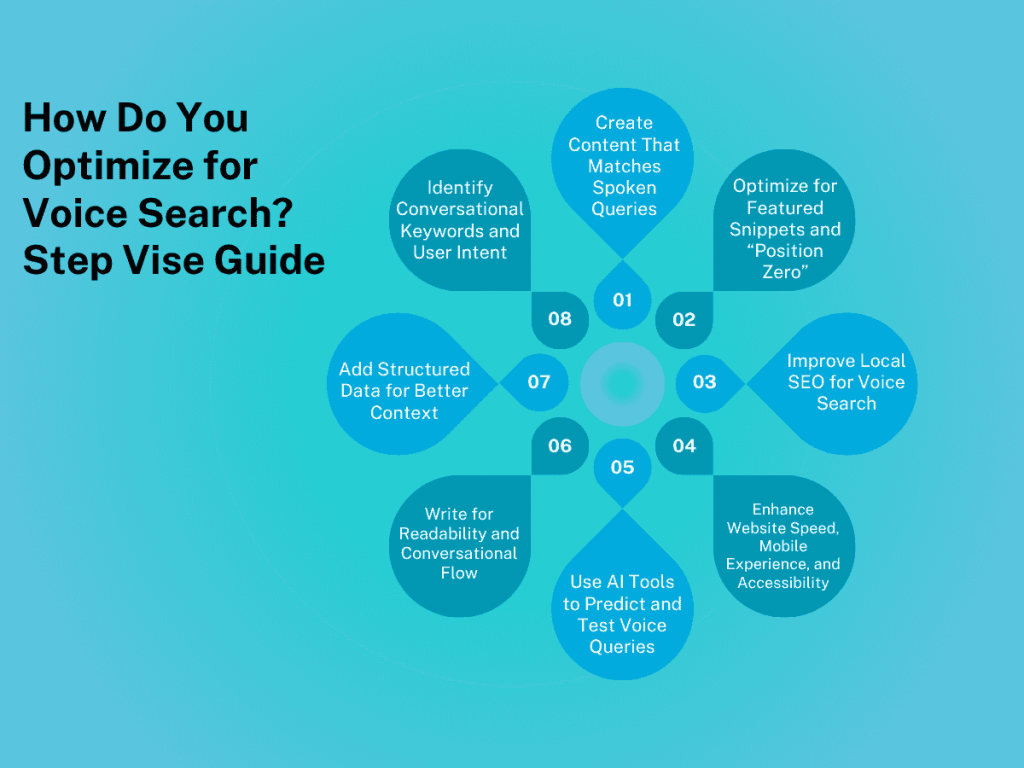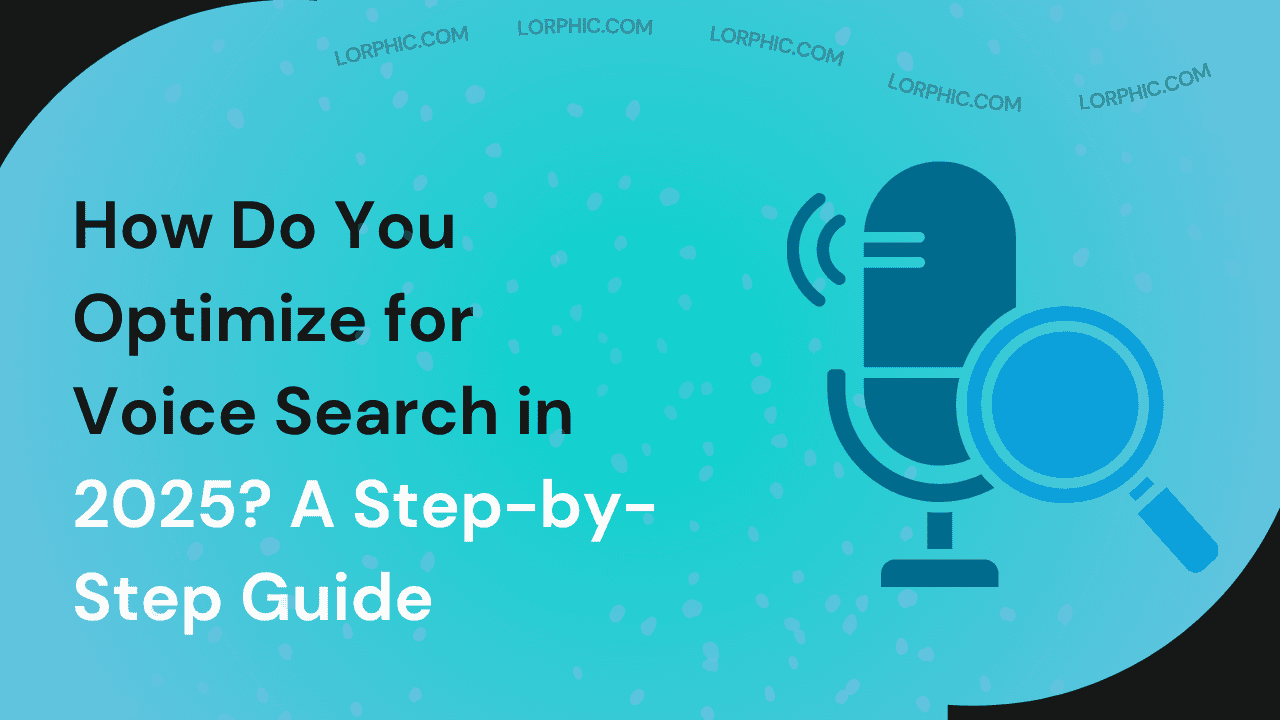The way people search for information is changing rapidly these days. Instead of writing short words, users are now asking full questions to tools like Google Assistant, Siri, or Alexa. This evolution made voice search optimization an integral part of modern SEO.
As 2025 rolls along, optimization of voice queries isn’t optional; it’s a necessity if you want to stay competitive. In this step-by-step guide, learn how do you optimize for voice search, what really sets voice searches apart, and the strategies you can use to rank higher in spoken results.
Understanding Voice Search Optimization
Voice search optimization means refining your website and content so they appear in results when people use voice assistants to search online. Instead of typing something like “best Italian restaurants,” users now simply ask, “What are the best Italian restaurants near me?”
With the growth of artificial intelligence assistants and natural language processing, voice searches have become more conversational and focused on intent. This shift means your SEO approach needs to evolve as well.
Why Does It Matters?
Voice search optimization offers several key benefits for businesses in 2025:
Better Visibility: Your brand has the opportunity to appear in voice results powered by AI platforms such as Google Assistant, Siri, and Alexa.
More Local Traffic: A large number of voice searches include local intent, such as people looking for services “near me” or places that are “open now.” In the context of local business searches, voice interactions remain critical — many voice queries include local intent like “near me,” making local optimization a key factor.
Enhanced User Experience: When your content sounds natural and conversational, it becomes easier for users to understand and interact with.
Future-ready SEO: As AI search tools continue to advance, optimizing for voice ensures your website stays relevant and competitive.
In simple terms, voice search optimization helps your business remain visible and accessible in an era where mobile devices and AI-driven search dominate how people find information.
How Do You Optimize for Voice Search? Step Vise Guide
Below is a detailed breakdown of how to optimize your website and content to meet the needs of voice search in 2025.

Identify Conversational Keywords and User Intent
Traditional SEO often targets short, typed keywords, but voice search is different. It focuses on longer, more conversational phrases that reflect how people naturally speak.
For instance:
Typed search: “weather New York”
Voice search: “What’s the weather like in New York today?”
How to Find the Right Keywords?
- Use tools such as AnswerThePublic, Google’s People Also Ask, and SEMRush to discover question-based keywords.
- Focus on natural phrases that begin with words like what, how, where, why, or when.
- Add local terms or phrases such as “near me” or “in [city name]” to target location-based queries.
These strategies help your content match the way real users interact with voice assistants rather than how they type in a search bar.
Create Content That Matches Spoken Queries
When users ask questions through voice assistants, the responses they hear are short, clear, and direct. To make your content suitable for voice search, it should sound natural and provide quick, valuable answers.
Begin by offering a short and precise answer within the first few sentences, followed by additional context or examples that add value. Using question-based subheadings also helps search engines recognize relevant information that matches how people ask questions.
For example, if someone asks, “How do you optimize for voice search?” your content could respond with, “You can optimize for voice search by focusing on conversational keywords, adding structured data, and improving your local SEO strategy.”
This style ensures that your content is easy for both users and search engines to understand, increasing the chances of being featured in voice search results.
Optimize for Featured Snippets and “Position Zero”
When users ask questions through voice search, assistants like Google Assistant or Alexa often pull answers from the top result on the page, commonly known as Position Zero or the featured snippet. Securing this spot can significantly boost your visibility.
How to Earn Featured Snippets?
- Present information clearly using bullet points, numbered lists, or tables.
- Add an FAQ section at the end of your posts to address common user questions.
- Use schema markup, such as FAQ or HowTo, to help Google understand your content’s structure.
Featured snippets make it easier for voice assistants to read your content aloud, which increases your chances of being selected as the spoken result. You can also use AI-powered insights to identify and refine the types of content formats that perform best for voice search visibility.
Improve Local SEO for Voice Search
Almost half of all voice searches are focused on local intent. People frequently use voice assistants to discover nearby services, such as “best coffee shops near me” or “restaurants open now.” To capture this audience, your website and business listings must be optimized for local search.
Start by ensuring that your Google Business Profile includes accurate business details like your address, contact number, and working hours. Incorporate local keywords naturally into your content so it feels authentic and relevant. Encourage happy customers to leave positive reviews since voice assistants often recommend highly rated businesses. Also, make sure your business information is consistent across all platforms and directories.
For companies that provide voice search optimization services, focusing on local SEO is essential because it directly influences how often your business appears in local voice-based searches and drives real-world conversions.
Enhance Website Speed, Mobile Experience, and Accessibility
Since most voice searches take place on mobile devices, it is essential that your website loads quickly and functions smoothly on smaller screens. A fast and user-friendly website not only improves user satisfaction but also boosts your visibility in both voice and traditional search results.
Optimization Tips
- Keep your page load time under two seconds for the best performance.
- Compress images and use lazy loading to reduce delays.
- Design buttons and links that are easy to tap on mobile screens.
- Add descriptive alt text and ARIA labels to make your site more accessible for all users.
A well-optimized, accessible website ensures visitors have a smooth experience, which increases your chances of ranking higher in search results.
Use AI Tools to Predict and Test Voice Queries
Artificial intelligence can help you better understand how users phrase their voice searches and what types of questions they ask. By simulating real voice interactions, AI tools allow you to identify trends, improve keyword targeting, and refine your content strategy for better results.
Tools such as ChatGPT or Gemini can help you generate conversational keyword ideas, while platforms like Surfer SEO and Ahrefs provide data-driven insights for content optimization. You can also use specialized AI tools designed specifically for analyzing voice-friendly ranking factors.
By incorporating AI into your voice search strategy, you can more accurately predict user behavior and fine-tune your content to stay aligned with changing AI-driven algorithms and search patterns.
Write for Readability and Conversational Flow
Your content should sound smooth and natural when spoken aloud. Avoid using complex words, long sentences, or technical jargon that might confuse readers or listeners.
Writing Tips
- Keep sentences short and clear, ideally under twenty words.
- Use simple transitions such as “for example,” “in other words,” or “that means” to connect ideas naturally.
- Maintain a friendly and conversational tone throughout your content.
- Write the way your audience speaks rather than using formal textbook language.
If your content sounds engaging and easy to follow when read aloud by a voice assistant, you have achieved the right balance of clarity and flow.
Add Structured Data for Better Context
Search engines depend on structured data to understand the purpose and meaning of your web pages. Adding schema markup helps search engines present your content in rich results and voice responses, improving your visibility and relevance.
Most Useful Schema Types for Voice SEO:
- FAQ Schema
- HowTo Schema
- LocalBusiness Schema
- Product Schema (for online stores)
Always test and validate your structured data using Google’s Rich Results Test to make sure it is accurate and visible to search crawlers. Properly implemented schema enhances your website’s context, making it easier for AI-powered voice assistants to deliver your content as precise answers to user queries.
Final Thoughts
Voice search is advancing rapidly, combining artificial intelligence, natural language understanding, and personalized results. Optimizing for it is more than just improving your rankings, it helps make your content easier to access, more engaging, and more trustworthy.
Businesses that start adapting now will stay ahead as search engines continue to become more conversational. Whether you are using AI-based voice search tools, enhancing your local SEO, or adjusting your content to sound more natural, taking action today will help secure your digital presence for the future.
FAQ’s
Why is voice search optimization important in 2025?
Voice search continues to grow with the rise of AI-driven devices. Optimizing for it ensures your content appears in voice responses, giving your business more reach and credibility.
How is voice search different from regular SEO?
Voice search focuses on natural language and question-based queries, while traditional SEO targets shorter, typed keywords. It’s about intent and conversation rather than just matching phrases.
How long does it take to see results from voice optimization?
Results depend on your niche and competition, but most websites start seeing improvements in 3–6 months with consistent optimization.
How to do voice search optimization?
To optimize effectively, focus on conversational keywords, improve mobile performance, add schema markup, and utilize AI voice search optimization tools for deeper insights.
Curated by Lorphic
Digital intelligence. Clarity. Truth.


